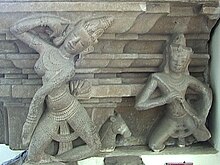
A Gandharva marriage (Sanskrit: गान्धर्व विवाह, gāndharva vivāha, IPA: [gənd̪ʱərvə vɪvaːhə]) is one of the eight classical types of Hindu marriage. This ancient marriage tradition from the Indian subcontinent was based on consensual acceptance between two people, with no rituals, witnesses or family participation.[1] The marriage of Dushyanta and Shakuntala was a historically celebrated example of this class of marriage.[2]
- ^ Catherine Benton (June 2006), God of Desire: Tales of Kamadeva in Sanskrit Story Literature, SUNY Press, 2006, ISBN 978-0-7914-6566-0,
... male counterparts of apsaras, gandharvas are known to love women; and women fall instantly for the charms of gandharva men ... awaken sexual passion in women ... In a gandharva marriage, a man and woman are so drawn to one another in mutual passion that they run off together without ceremony or consent of their families ...
- ^ Johann Jakob Meyer (1971), Sexual life in ancient India: a study in the comparative history of Indian culture, Motilal Banarsidass Publishers, 1989, ISBN 978-81-208-0638-2,
... Gandharva marriage, which is also part of the orthodox system ... Dushyanta. This king's Gandharva marriage with Cakuntala, which is well-known especially through Kalidasa's drama, is a celebrated example ... only for warrior nobility according likewise to Manu ... Narada states without hesitation that this kind of marriage belongs to all castes alike ... 'survival from the time of promiscuity'; might well be understood from an "inter-ethnic" standpoint ...